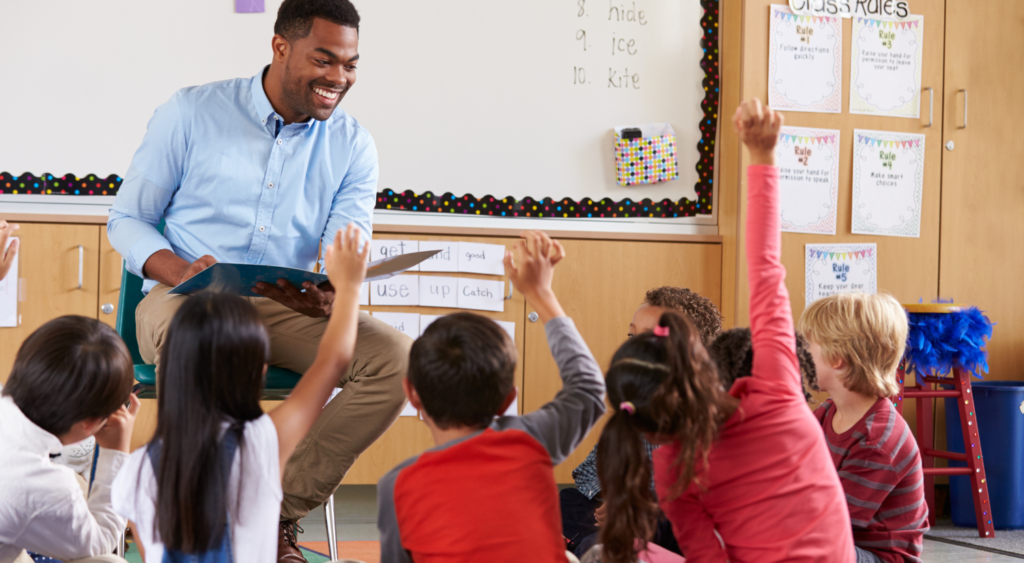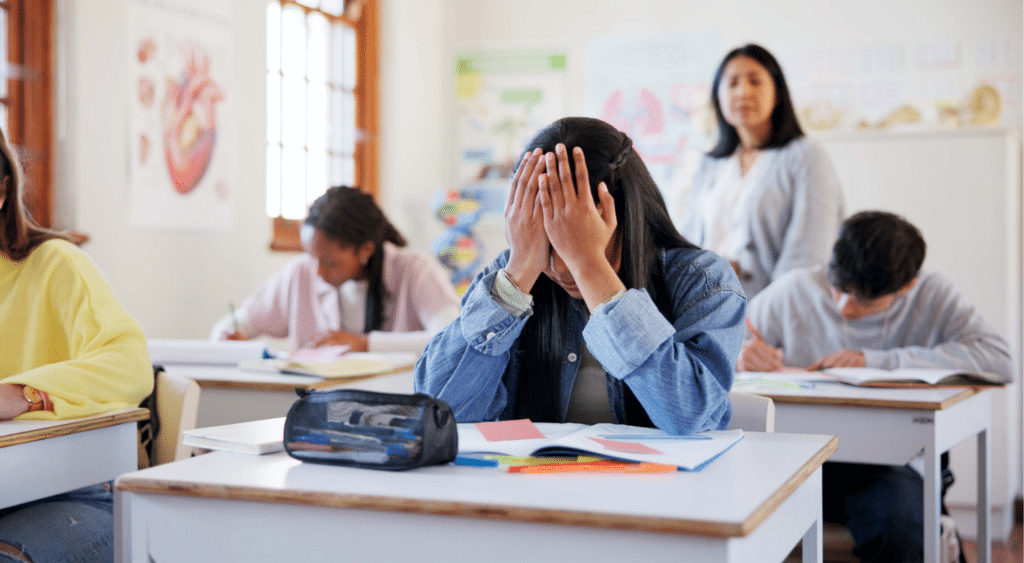Substitute teacher tips: Attention getters for elementary school students.

Classroom management is one of the most challenging responsibilities for substitute teachers—whether you’re a seasoned veteran or new to the game. Using attention getters for elementary school can help you get students’ eyes back on you.
Most teachers already use them, so students are used to the cues. So, whenever possible, use the teacher’s attention getters. Following a teacher’s routine is better than introducing your own thing. However, if the teacher doesn’t already have one – then it’s good to have your own ready to go.
Note that attention getters cater to several learning styles. In this article, we’ll explore a few that combine auditory, visual, and kinesthetic tools.
Visual attention getters for elementary school.
When bringing your class back on track, you don’t want to add more noise to the chaos. This is especially true in a class full of kindergartners or first graders. So, it might be better to get the class back on task with a visual cue.
- Show a countdown clock or other interactive display on the whiteboard. This can even be done by holding up five fingers and slowly moving your fingers down to one. Students usually join in and count down from five.
- Hold up cards that signal for students to get on the carpet or in their seat.
- Put a finger on your lips and hold up a zero. This is common in many schools as a signal for quiet. It works effectively in the hall, where you don’t want to add noise that could disturb other classes.
- Stop in front of the line and hold a zero while making eye contact with talkers. They will mimic you and stop making noise.
- Bring green and red cards (think traffic light) in your substitute teacher bag to use as a visual stop-and-go.
- Flashing overhead lights can also be a quick and easy teacher attention getter.
Call and response attention getters elementary students love.
Call and response is as simple as it sounds. You say something to the students, and they call it back. It quickly gets their attention, and honestly, it’s fun. Simple ones, like 1, 2, 3… eyes on me, don’t typically need an introduction. However, anything can be a call and response as long as you establish it. A few to try include:
- Teacher: What does a waterfall say?
- Students: Shhhh.
- Teacher: Hocus pocus.
- Students: Everybody focus.
- Teacher: To infinity.
- Students: And beyond.
- Teacher: Peanut butter.
- Students: Jelly time!
- Teacher: Holy!
- Students: Guacamole.
You might also make a call and response for what you want them to do. For example, I’ve asked them about their body positioning and posture.
- Teacher: Eyes where?
- Student: Forward.
- Teacher: Feet where?
- Student: Quiet.
You’re only limited by your imagination when it comes to call and response. You might create calls from popular movies or sports. Students enjoy relating to pop culture.
Make it about motion.
As a substitute teacher, you’ll find that some kids just need to move. To get their attention, give them a chance to get up and wiggle. This is especially important in lower elementary.
Have them mirror you. For example, say, “Mirror me,” and you might touch different parts of your face. Then, the students will mirror you.
Wiggle it out for five seconds. Say, “Wiggle,” and start moving around. The students will mimic you. Count down to five and say, “Freeze.” Sometimes, a little movement break is all they need to refocus.
Matching movement can also be a great way to help them move around for a minute. Stand up and say, “Match my movement.” You start doing random actions, like lifting your arm and touching your toes.
Clap your class back into attention.
Clapping is by far one of the best ways to get little learners involved and on track. One of our favorite go-to classroom attention getters is like a call and response but also requires a bit of movement. Clap out a rhythm, and have students clap it back. Have a little fun with it. Change the rhythm to make it less predictable.
One teacher tells us that she adds a little fun to the mix. Say, “Everybody freeze!” Then, like in the song “Cha Cha Slide,” you start clapping fast. You can even start singing, “How low can you go?” The clapping should get lower and lower. I end with another freeze.
Sing it for all the world to hear.
Singing is a great way to grab students’ attention and pull them back in. You can use any song to create a simple chant. It’s best to use a tune the students already know.
For example, you might use the tune of “Twinkle, Twinkle Little Star” to sing:
“Hands up high, hands down low,
Hands are quiet, and we know.
Eyes are watching, mouths are closed,
Ready to learn, here we go!”
A few more teacher suggestions:
- “Baby Shark” “It’s time to learn, doo, doo, doo, doo.”
- “The Final Countdown,” and then count down from ten together.
- Taylor Swift’s “You Need to Calm Down” is also a good choice to get the attention of elementary students. You’ll find that many of your students are Swifties.
Give chimes a try.
Alarms, chimes, and doorbells already draw our attention. So, they can be a great choice for elementary school attention getters.
Pick something that you can easily slip into your substitute teaching bag. Then, just ring it when you need to have the class clean up or listen for instruction. It’s also a great auditory cue for switching from one subject to another.
Why use attention getters in the classroom?
Teachers know that staying calm and not raising your voice is one of the keys to gaining the respect of their students. That’s why attention getters are used in every classroom and school. They help you establish your expectations, redirect the focus back to you, and keep students engaged in the lesson.
When you add classroom attention getters to your toolbox of instructional strategies, they add familiarity to the class. This reduces the time you take to redirect the classroom and makes teaching more effective.
Grow as a substitute teacher with Kelly Education.
Thinking about working at the elementary level? We’ve got many more articles with helpful guidance. Here are a few more:
If you or someone you know is interested in substitute teaching jobs, fill out our brief interest form, and one of our recruiters will contact you to answer your questions. We’ll also share more about opportunities to become a substitute teacher or support staff with one of our school district partners.
View Related: Article Workplace culture
You might like
What to wear as a male substitute teacher.
3 minute read
What to wear as a male substitute teacher.
3 minute read
Find your next job
Discover thousands of temporary, full-time, and remote jobs for beginning and experienced job seekers.



